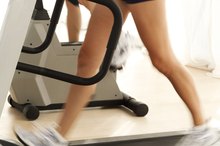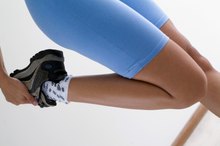Running and Pain in the Tibialis Anterior Muscle
Running is a high-impact form of exercise, and although it promotes weight loss and improves heart and lung function, it can also take its toll on the body. The tibialis anterior is a muscle in the leg that is often associated with running pain. In the worst of cases, pain in this muscle can cause you to be sidelined for an extended period. Knowing what to do about this condition can get you back into your routine and help prevent future episodes.
Specific Condition
The tibialis anterior muscle runs down the shin in front of the large tibia bone. Pain along the path of this muscle is often referred to as "shin splints." In medical terminology, this is called medial tibial stress syndrome, or MTSS for short.
Causes of Pain
The Best Treadmill Incline to Slim Legs
Learn More
The function of the tibialis anterior muscle is to dorsiflex and invert the foot. You perform dorsiflexion when you bend your ankle and point your toes toward your shin. Foot inversion takes place when you turn your foot inward. Under normal circumstances, these motions do not cause any problems. However, when you overload the tibialis anterior muscle, pain can develop. This is generally caused from running on uneven surfaces, running downhill and making fast cuts while running.
- The function of the tibialis anterior muscle is to dorsiflex and invert the foot.
- However, when you overload the tibialis anterior muscle, pain can develop.
Noninvasive Treatment
Resting is one of the best ways to treat shin pain. If you continually place force on your legs and activate your tibialis anterior muscles, you will slow your recovery time. The pain from shin splints is often accompanied by swelling. The best way to reduce this is by elevating the injured leg and wrapping it with a bandage. Applying ice packs wrapped in towels or bags of frozen vegetables also helps keep the pain down.
- Resting is one of the best ways to treat shin pain.
- The best way to reduce this is by elevating the injured leg and wrapping it with a bandage.
Preventive Exercise
Calf & Heel Pain
Learn More
Exercise to strengthen the muscles of your lower legs. This preventive measure can reduce the chances of shin pain. A basic exercise to work the shins is called a wall raise. Simply lean against a wall with your back touching it and lift your toes up toward your shins as you balance on your heels. Slowly lower your feet and repeat. Walking on your toes and walking on your heels also helps strengthen the muscles of the lower legs.
- Exercise to strengthen the muscles of your lower legs.
- Walking on your toes and walking on your heels also helps strengthen the muscles of the lower legs.
Tips to Consider
Exercising without a proper warmup raises your risk of shin splints. The best approach is to do a series of dynamic stretches before your workouts, then increase your running speed gradually. Dynamic stretches move the body through a range of motion which acclimates your body to exercise. Leg swings, ankle bounces, high knees and reverse lunges are dynamic stretches. Your footwear also plays a role in shin pain. If you run in worn-out shoes, your running mechanics can be thrown off, which causes excess stress on your shins. Make sure to get new running shoes every few months to prevent this from happening.
- Exercising without a proper warmup raises your risk of shin splints.
- If you run in worn-out shoes, your running mechanics can be thrown off, which causes excess stress on your shins.
Related Articles
References
- GetBodySmart: Tibialis Anterior Muscle
- American Council on Exercise: Is it Better to Stretch Before or After My Workout?; Jessica Matthews
- Callahan LR. Overview of running injuries of the lower extremity. UpToDate. Updated May 28, 2020.
- Alaia MJ. Diseases & Conditions: Shin Splints. OrthoInfo. American Academy of Orthopaedic Surgeons. Reviewed August 2019.
- Shin Splints. Merck Manual Professional Version.
- Callahan LR. Overview of running injuries of the lower extremity. Updated May 28, 2020.
- Shin splints - self care. MedlinePlus NIH.
Writer Bio
I am very genuine and magnetic on camera, and have made numerous videos on my own for clients and other organizations that I'm affiliated with. I also have a degree in Sport Management, and multiple certifications to back up my validity. I've also been featured in three different exercise infomercials and had a speaking role in a National Lampoons movie.









